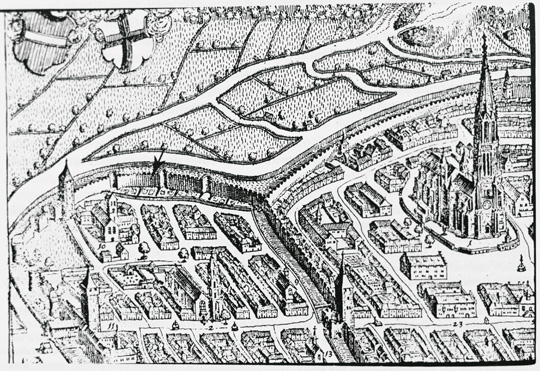A Freiburg institution
The history and development of the Botanical Garden
| The University of Freiburg was founded in 1457. The history of its Botanical Garden begins about two centuries later and has been closely connected with the University ever since. With its scientific successes and technical innovations over time, it has become an institution that is more than just a garden. |

"Die Statt Freyburg Im Breysgaw" around 1644. The location of the first Botanical Garden is thought to be even further south of the city wall than shown here (arrow). Figure: Merian, Matthäus & Zeiller, Martin (1644): Topographia Alsatiae. Universitätsbibliothek Freiburg.
The “Hortus Medicus” was founded in 1620 in the Freiburg district of Neuburg near today’s Stadtgarten. Under the direction of the botanist Jacobus Walter, scientists and students were able to observe and study plants for medicinal purposes. The statutes of the Faculty of Medicine of 1624 recognized the garden as an independent educational institution. This first garden was largely destroyed during the Thirty Years’ War, and in 1677 it had to make way for the fortifications of French occupying troops. It was not until 1766 that a 2.7 hectare large and systematically laid out Botanical Garden was created near the Kronenbrücke on the Dreisam. This placed the work of researchers and teachers in the foreground, thanks to the upswing in botany and the natural sciences in the second half of the 18th century and the influence of enlightened physicians at the University of Freiburg, such as the then director of the Botanical Garden Franz Joseph Lambert Baader. From 1829 onwards, the Botanical Garden housed about 3000 plant species and one year later began to exchange seeds with other gardens worldwide.
Facility for research and teaching
Over the years it became clear that the garden no longer met the requirements of research and teaching. In addition, a road through the garden was planned due to the expansion of the city. From 1880 onwards, therefore, a complex with modern greenhouses and a lush collection of trees was built on the site of today’s physics building in the Natural Sciences Campus, but soon required more space than was available. The former “Hortus Medicus” moved for the last time in 1914. The garden, which was geographically divided into different zones, was laid out at its present location in Schänzlestraße in the Herdern district. At the same time, the area was enlarged and the building for the institute and a greenhouse complex were built. The open-air facility, completed in 1920, was divided into different areas for demonstration purposes. These areas were intended to represent vegetation areas such as temperate Asia and America as well as vegetation elements such as in the Mediterranean and various biotopes such as alpine vegetation and swamps, a division that has been maintained since the Botanical Garden was redesigned at the end of the 1960s with minor adjustments.
Fern plants, tropical plants, species from French Guyana or water-storing succulents: Today’s public greenhouses cover an area of about 910 m², divided according to themes and regions. The horticultural team cultivates more than 250 species of crop plants in the nurseries, and around 6000 different plant species from all over the world grow in the greenhouses and the open-air area. The horticultural team has reduced the number of species in recent years in order to cultivate them in larger groups close to nature. In order to adapt the stock to the demands of current research, they have to replant them constantly. About 500 gardens worldwide participate in the international seed exchange. The Botanical Gardens send seeds and other plant material to Botanical Gardens and scientific institutions, which use them in accordance with the Convention on Biological Diversity.
Meeting place for the public
The third Botanical Garden on the Natural Sciences Campus allowed access for the first time and explicitly also interested visitors from outside the University. In a report from 1898, a gardener at the time explained that the collection of correctly named, well-kept, technically and scientifically important plants was to be arranged in such a way "that they appear once to the botanist to be easy to survey, but then also to please the garden and flower lover".
After its destruction in an air raid in 1944, the garden was rebuilt together with the greenhouses from 1946 to 1955. In the 1960s and 1970s, the modern institute building, new greenhouses and an operating building were constructed. The director at the time, Prof. Dr. Dieter Vogellehner, had the Botanical Garden designed until 1974 under the guiding theme of evolution. The concept with open-air area and family tree model still characterizes the central structure of the institution today. Above all, the walkable phylogenetic tree illustrates the development of flowering plants during evolution and the natural interrelationships of the various orders and families of flowering plants. Although the system no longer corresponds to the current state of knowledge in molecular systematics, it allows a comparison with today's view through a constantly updated family tree based on modern research.
Since 2002 Prof. Dr. Thomas Speck has been director of the Botanical Garden under whose direction new cultivation greenhouses and an entrance area were built. From 2010 to 2016 he had the show house complex renovated and technical installations renewed. Speck and his team have turned the Botanical Garden into a place where researchers study structures and functions of plants and transfer them into biomimetic materials and applications. At the same time, visitors can enjoy the diversity of native and exotic plants here. For even today, the institution is still a meeting place for citizens who want to find peace and quiet, relax and observe and get to know numerous plant species in this “showcase of research.”
Patrick Siegert



